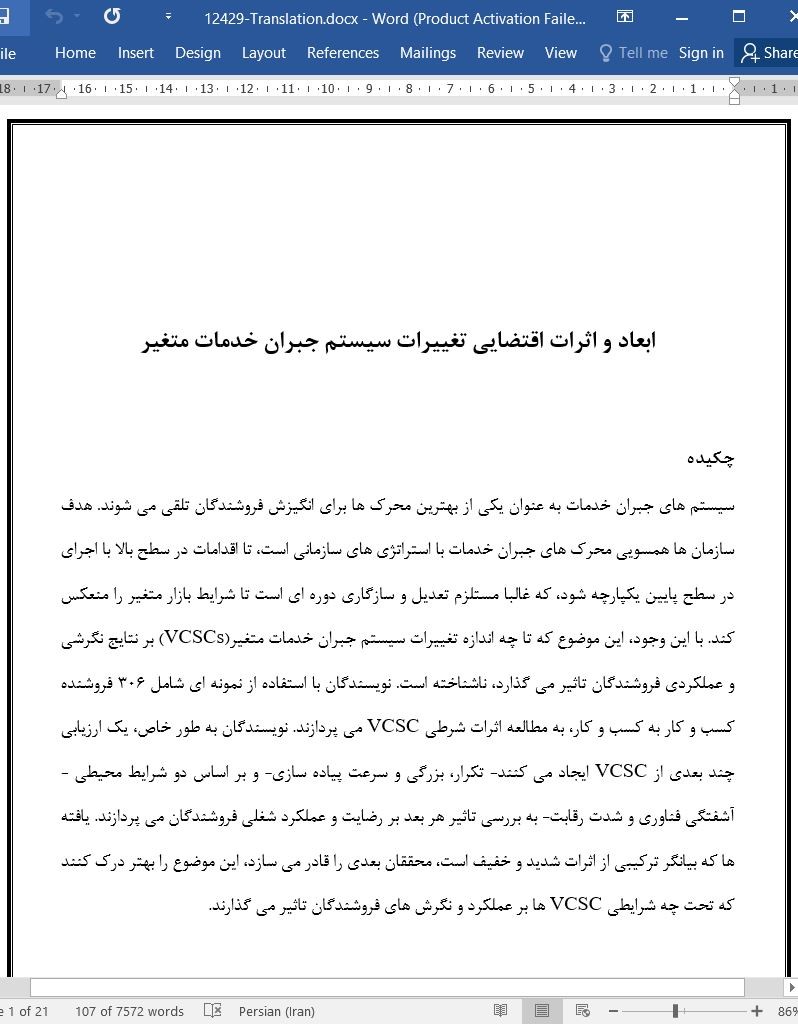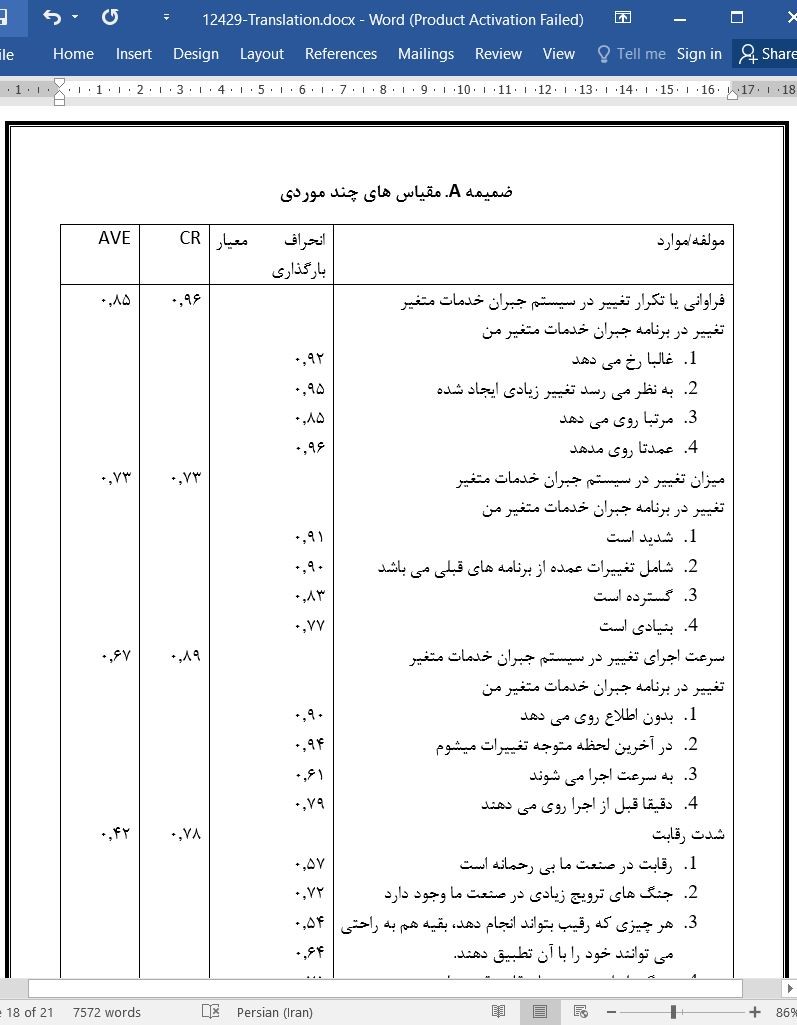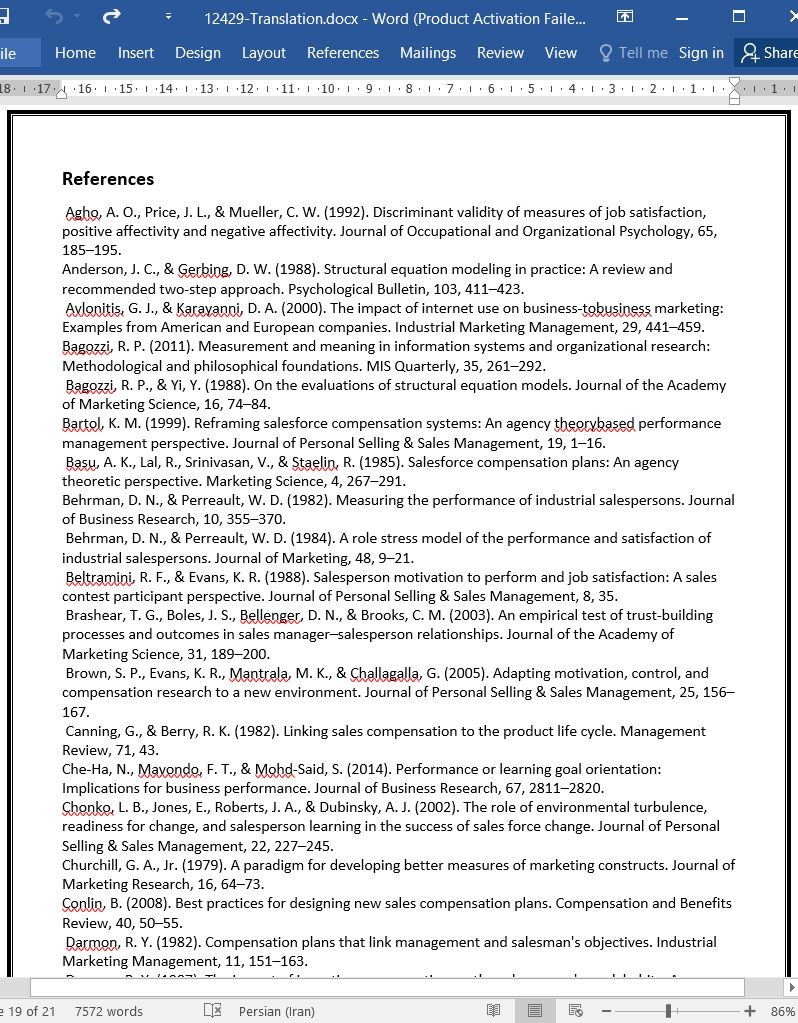
دانلود مقاله ابعاد و اثرات اقتضایی تغییرات سیستم جبران خدمات متغیر
چکیده
سیستم های جبران خدمات به عنوان یکی از بهترین محرک ها برای انگیزش فروشندگان تلقی می شوند. هدف سازمان ها همسویی محرک های جبران خدمات با استراتژی های سازمانی است، تا اقدامات در سطح بالا با اجرای در سطح پایین یکپارچه شود، که غالبا مستلزم تعدیل و سازگاری دوره ای است تا شرایط بازار متغیر را منعکس کند. با این وجود، این موضوع که تا چه اندازه تغییرات سیستم جبران خدمات متغیر(VCSCs) بر نتایج نگرشی و عملکردی فروشندگان تاثیر می گذارد، ناشناخته است. نویسندگان با استفاده از نمونه ای شامل 306 فروشنده کسب و کار به کسب و کار، به مطالعه اثرات شرطی VCSC می پردازند. نویسندگان به طور خاص، یک ارزیابی چند بعدی از VCSC ایجاد می کنند- تکرار، بزرگی و سرعت پیاده سازی- و بر اساس دو شرایط محیطی - آشفتگی فناوری و شدت رقابت- به بررسی تاثیر هر بعد بر رضایت و عملکرد شغلی فروشندگان می پردازند. یافته ها که بیانگر ترکیبی از اثرات شدید و خفیف است، محققان بعدی را قادر می سازد، این موضوع را بهتر درک کنند که تحت چه شرایطی VCSC ها بر عملکرد و نگرش های فروشندگان تاثیر می گذارند.
مقدمه
فروشندگان کسب و کار به کسب و کار(B2B) مجریان عملیاتی استراتژی های سازمانی و بازاریابی هستند. دانشگاهیان و کارشناسان سالهاست که به کشف روش های هماهنگی استراتژی های نیروی فروش با سیستم های جبران خدمات مناسب به منظور تشویق رفتارهای فروش مطلوب، علاقه مندند(کرافت، د کارلو، پاجول و تانر،2012؛ زولتنرز، سینها و زولتنرز،2001). این فرآیند برای اجرای استراتژی های گسترده تر سازمانی، دستیابی به اهداف فروش، و در نهایت بهبود عملکرد فروش ضروری است( کانلین، 2008). بنابراین، سیستم های جبران خدماتی که به درستی طراحی شده باشد، منجر به عملکرد بالا می شود، با توجه به اینکه روش های کلیدی تاثیر بر فروشندگان هستند، توجه به پژوهش را ضروری می سازد (بارتول، 1999؛ لوپز،هاپکینز و رایموند،2006).
از آنجا که محیط فروش سخت تر و پیچیده تر شده است و نقش فروش و وظایف ضروری آن نیز به سرعت در حال تغییر است، به سیستم های پاداش انطباقی نیاز است(لوپز و همکاران، 2006؛ راجو و سیرینیواسان،1996). کانلین(2008،ص.50) بیان می کند همانگونه که سازمانها در واکنش به این تغییرات نحوه انجام کار خود را تغییر می دهند، سیستم های جبران خدمات نیز باید به طور مستمر تکامل یابند؛ در غیر اینصورت، زمانی که به نمایندگان فروش برای فروش امسال، مطابق اهداف سال گذشته شرکت پرداخت صورت گیرد، احتمال دارد شرکت نتواند به اهداف مد نظرش، دست یابد. مدیران فروش افرادی هستند که با مسائل واقعی مربوط به نحوه انگیزش فروشندگان برای دستیابی به اهداف استراتژیک، در محیط دائما درحال تغییر فروش سرو کار دارند(کاستر و کانالز،2011؛ پولینز، 2001). هدف این مطالعه ایجاد درک بهتری از ابعاد تغییر در جبران خدمات متغیر نیروی فروش است (به طور مثال، جبران خدماتی که متغیر است مانند، کمیسیون و پاداش) و اینکه چگونه تغییرات سیستم جبران خدمات با شرایط محیطی مختلف در ارتباط است تا عملکرد و نگرش های کارکنان فروش را پیش بینی کند.
5.3. محدودیت ها و راهنمایی هایی برای تحقیقات آتی
این مطالعه به بررسی اثرات اقتضایی VCSC ها بر عملکرد فروشندگان و رضایت شغلی در طیف وسیعی از صنایع می پردازد. بنابراین، از رویکرد ارزیابی نظر سنجی چند مقطعی در صنایع مختلف، استفاده شد. این مقاله بررسی تمام ابعاد VCSC و نیز متغیرهای تعدیل گر سطح صنعت را امکان پذیر می کند. با این وجود نظر سنجی مقطعی مانع بررسی اثرات VCSC ها در طول زمان می شوند. تحقیقات آتی با ارزیابی طولی ابعاد VCSC ها ممکن است حاوی اطلاعات مفید و جدیدی باشد. اگر دستکاری های تجربی اضافه می شد، این مقاله می توانست تاثیر گذارتر باشد.
Abstract
Compensation systems are regarded as one of the best incentives to motivate salespeople. Organizations aim to align compensation incentives with organizational strategies in order to integrate top-level initiatives with ground-floor implementation, often requiring periodic adjustments to reflect fluctuating market conditions. What is not known, however, is to what extent variable compensation system changes (VCSCs) impact the attitudinal and performance outcomes of salespeople. Using a sample of 306 business-to-business salespeople, the authors study the conditional effects of VCSC. Specifically, the authors conceptualize a multi-dimensional assessment of VCSC – frequency, magnitude, and implementation speed – and investigate each dimension's effect on salesperson job satisfaction and performance, contingent upon two environmental conditions—technological turbulence and competitive intensity. Findings show a mixture of accentuating and attenuating effects on both outcomes, allowing future researchers to gain a better understanding of under which conditions VCSCs impact salesperson attitudes and performance.
1. Introduction
Business-to-business (B2B) salespeople are frontline implementers of organizational and marketing strategies. Academics and practitioners alike have long been interested in uncovering methods of aligning sales force strategies with proper compensation systems in order to drive desirable sales behaviors (Krafft, DeCarlo, Poujol, & Tanner, 2012; Zoltners, Sinha, & Zoltners, 2001). This process is essential to implementing broader organizational strategies, attaining sales targets, and ultimately, improving sales performance (Conlin, 2008). Thus, well-designed compensation systems, which induce high performance, warrant research attention given they are key methods of influencing salespeople (Bartol, 1999; Lopez, Hopkins, & Raymond, 2006).
As the selling environment is becoming increasingly complex and demanding, and the sales role and its task requirements are also rapidly changing, adaptive reward systems are requisite (Lopez et al., 2006; Raju & Srinivasan, 1996). Conlin (2008, p.50) indicates compensation systems must continuously evolve as organizations adjust their course of action in response to such changes; otherwise, “when your sales representatives are getting paid for this year's sales based on last year's corporate goals, chances are your company isn't going anywhere it wants to go.” Sales managers are thus confronted with the realistic concern of how to best incentivize salespeople to achieve strategic objectives within this ever-changing selling environment (Küster & Canales, 2011; Pullins, 2001). The aim of this study is to capture a better understanding of the dimensions of change to salespeople's variable compensation (i.e., compensation that fluctuates, such as commission and bonuses) and how these compensation system changes interact with various environmental conditions to predict salesperson performance and attitudes.
5.3. Limitations and future research directions
This study examines on salesperson performance and job satisfaction across a range of industries.Accordingly, the assessment approach utilized is a multi-industry, cross-sectional survey. This context allows for the exploration of all VCSC dimensions, as well as the incorporation of industrylevel moderating variables. However, a cross-sectional survey precludes the examination of VCSC effects over time. Future research incorporating a longitudinal assessment of VCSC dimensions may prove illuminating. This effort could be particularly impactful if experimental manipulations are included.
چکیده
1. مقدمه
2. مروری برتحقیقات پیشین
2.1. سیستم های جبران خدمات
2.2. ابعاد تغییر جبران خدمات متغیر
3. مبانی مفهومی
3.1. تئوری انتظار و انگیزش
3.2. مدل تحقیق
4. روش شناسی
4.1. اندازه گیری و پایایی
4.2. تحلیل
4.3. مدل اندازه گیری و آزمون مدل
4.4. نتایج
5. بحث
5.1. مشارکت نظری
5.2. مفاهیم مدیریتی
5.3. محدودیت ها و راهنمایی هایی برای تحقیقات آتی
منابع
Abstract
1. Introduction
2. Literature review
2.1. Compensation systems
2.2. Dimensions of variable compensation change
3. Conceptual foundations
3.1. Motivation and expectancy theory
3.2. Research model
4. Methodology
4.1. Measures and reliability
4.2. Analysis
4.3. Measurement model and model testing
4.4. Results
5. Discussion
5.1. Theoretical contribution
5.2. Managerial implications
5.3. Limitations and future research directions
References
- اصل مقاله انگلیسی با فرمت ورد (word) با قابلیت ویرایش
- ترجمه فارسی مقاله با فرمت ورد (word) با قابلیت ویرایش، بدون آرم سایت ای ترجمه
- ترجمه فارسی مقاله با فرمت pdf، بدون آرم سایت ای ترجمه



